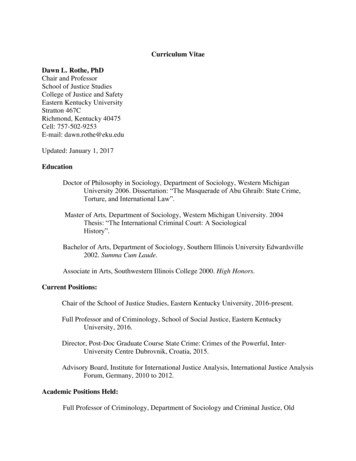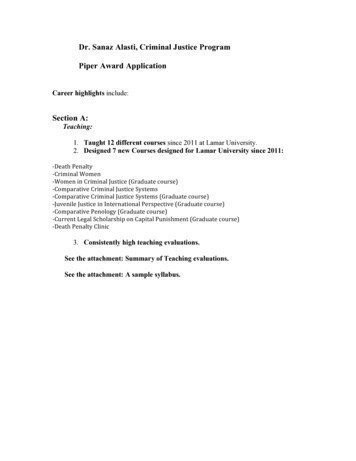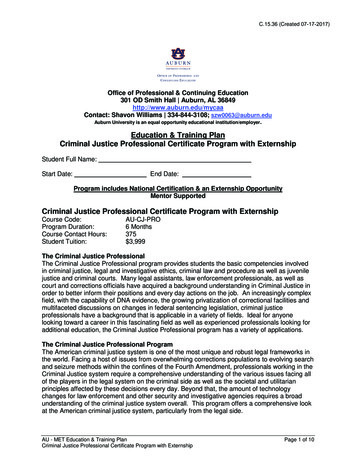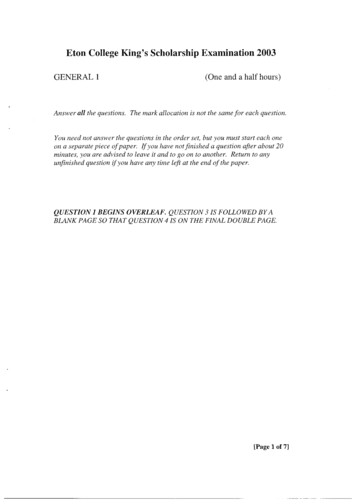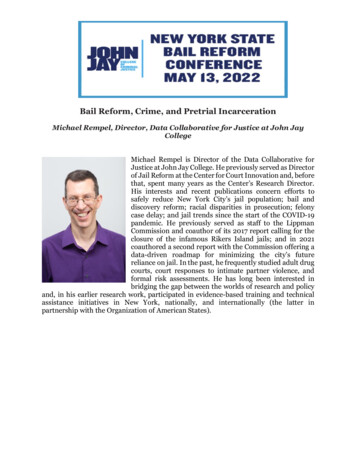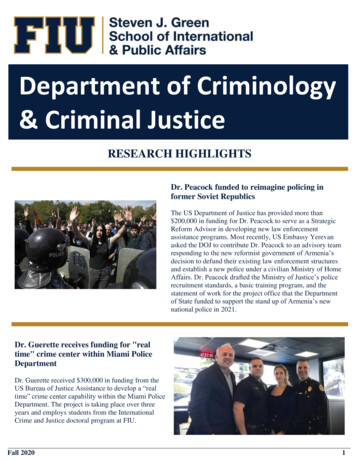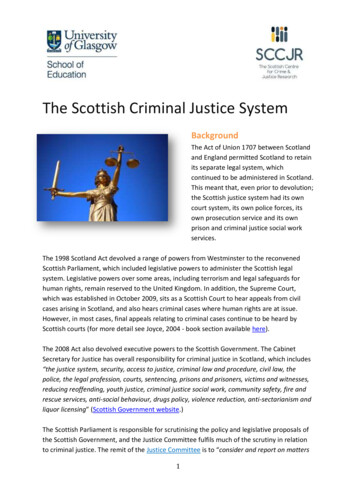
Transcription
The Scottish Criminal Justice SystemBackgroundThe Act of Union 1707 between Scotlandand England permitted Scotland to retainits separate legal system, whichcontinued to be administered in Scotland.This meant that, even prior to devolution;the Scottish justice system had its owncourt system, its own police forces, itsown prosecution service and its ownprison and criminal justice social workservices.The 1998 Scotland Act devolved a range of powers from Westminster to the reconvenedScottish Parliament, which included legislative powers to administer the Scottish legalsystem. Legislative powers over some areas, including terrorism and legal safeguards forhuman rights, remain reserved to the United Kingdom. In addition, the Supreme Court,which was established in October 2009, sits as a Scottish Court to hear appeals from civilcases arising in Scotland, and also hears criminal cases where human rights are at issue.However, in most cases, final appeals relating to criminal cases continue to be heard byScottish courts (for more detail see Joyce, 2004 - book section available here).The 2008 Act also devolved executive powers to the Scottish Government. The CabinetSecretary for Justice has overall responsibility for criminal justice in Scotland, which includes“the justice system, security, access to justice, criminal law and procedure, civil law, thepolice, the legal profession, courts, sentencing, prisons and prisoners, victims and witnesses,reducing reoffending, youth justice, criminal justice social work, community safety, fire andrescue services, anti-social behaviour, drugs policy, violence reduction, anti-sectarianism andliquor licensing” (Scottish Government website.)The Scottish Parliament is responsible for scrutinising the policy and legislative proposals ofthe Scottish Government, and the Justice Committee fulfils much of the scrutiny in relationto criminal justice. The remit of the Justice Committee is to “consider and report on matters1
falling within the responsibility of the Cabinet Secretary for Justice, and functions of the LordAdvocate other than as head of the systems of criminal prosecution and investigation ofdeaths in Scotland.” (Scottish Parliament website). A Justice Sub-Committee on Policing wasestablished to oversee the operation of the Police and Fire Reform (Scotland) Act 2012 as itrelates to policing.Legal frameworkCivil LawScots Law is divided into two main categories: civil law and criminal law. Civil law (alsoreferred to as ‘private law’) is, broadly speaking, about the rights of obligations of individualsand organisations (and not the state), and has been derived from the principles of RomanLaw.Criminal LawCriminal law is a form of public law. Public law concerns the structure of government (suchas constitutional law) and the powers, duties and obligations of officials and of citizens.Though crime generally involves an act against another person (or another’s property), inlegal terms it constitutes an act against the state. The state then has the power to impose anappropriate punishment on the individual who has offended. Criminal law is the primarilyfocus of this briefing.Legislation and Common LawScots Law is derived from both legislation (laws passed by the UK Houses of Parliament andScottish Parliament) and common law. Unlike legislation, common law is not laid out in anauthoritative document (such as an Act of the UK or Scottish Parliament). Instead, thecommon law on any topic is generally derived from a series of court judgements ruling onthe application of common law principles.A more detailed account of how Scots Law works can be found in a briefing paper producedby the Scottish Parliament Information Centre (SPICe).Police serviceSince 1 April 2013, Scotland has had a single national police force – the Police Service ofScotland (also referred to as ‘Police Scotland’). This new police service replaces eightpreviously separate territorial police forces and associated agencies, such as the ScottishCrime and Drug Enforcement Agency. This was one of a number of reforms provided for inthe Police and Fire Reform (Scotland) Act 2012.The Police and Fire Reform (Scotland) Act 2012 set out the general duties of police officers: to prevent and detect crime2
to maintain order to protect life and property to take lawful measures, and make such reports to the appropriate prosecutor, as maybe needed to bring offenders to justice with due speed to serve and exclude warrants, citations, etc. to attend court to give evidence.(Source: SPICe Briefing - The Scottish Criminal Justice System: The Police)What happens when a crime is committed?In accordance with these duties, the police force has a responsibility to respond to criminalactivity. When a crime is thought to have been committed, a victim or witness might reportthis to the police.We must remember that not all crime is reported to the police. There are variousreasons why people might choose not to report a crime.According to the Scottish Crime and Justice Survey, some of the reasons include: feeling that the police could not do anything about it considering the incident too trivial to report feeling that the police would not be interested fear of reprisals from those accused the crime was considered a private or family matter. This attitude might surfacein the case of incidents of domestic abuse, sexual violence, child abuse andother crimes that typically occur in private, in the family home.This mismatch between the numbers of crimes reported to the police and the actualnumber of crimes that take place is known as the ‘dark figure’ of crime.For information on why victims of sexual violence, particularly rape, choose notreport,SCCJR to‘Violenceagainstand girls’.Alltocrimethatseeis reportedthe policeshouldwomenbe recorded,and statistics revealing the levelof crime and types of crime are published each year. The Scottish Government publicationRecorded Crime in Scotland, 2017-2018 presents findings about the crime recorded by thepolice in Scotland over the 12-month period from April 2017 to March 2018.Some key findings from the report include: Crimes recorded by the police in Scotland increased by 1% from 238,651 in 2016-17 to244,504 in 2017-18.Looking at longer term trends recorded crime has fallen in the last 20 years (theScottish police recorded 421,000 crimes and 487,000 offences during 1997) but therehas been significant variations in relation to different crimes and offence types. For3
example there were far more crimes of dishonesty recorded in 1997 (267,207) than in2017-18 and far less crimes of indecency (7,147) than what is recorded today.‘Crimes of dishonesty’, which include housebreaking, theft by opening a lock fast place,theft from a motor vehicle, theft of a motor vehicle, shoplifting, other theft and fraud,accounted for the greatest number of recorded crime, with 114,474 cases recorded.‘Fire-raising, vandalism etc.’ accounted for 51,322 crimes.‘Other crimes’, which include crimes against public justice (perjury, resisting arrest, bailoffences, wasting police time), handling offensive weapons and drug offences,amongst others, accounted for 58,970 crimes.‘Non-sexual crimes of violence’, which include homicide (murder, culpable homicide),attempted murder, serious assault, robbery and other acts of violence, accounted for atotal of 7,251 crimes.‘Sexual crimes’, which include rape and attempted rate, sexual assault, crimesassociated with prostitution, and some other sexual crimes, accounted for12,487 crimes.The chart below illustrates the extent of each of each type of crime, expressed as apercentage of all crime recorded by the police in 2017-18.Crimes recorded by the police, 0%24.0%15.0%10.0%5.0%3.0%5.0%0.0%Non-sexual acts ofviolenceSexual crimesCrimes ofdishonestyFire-raising,vandalism etc.Other crimesIn addition to these crimes recorded, the Scottish Crime and Justice Survey 2016-17 A total of 712,000 crimes were committed against adults in 2016-17, down by nearly athird since 2008-09 but no change detected since 2014-15. Most of the crime (68%) was related to property eg. vandalism, household theft,personal theft, motor vehicle theft and housebreaking. Violent crime made up the rest (32%) which refers to minor assault with no injury,4
minor assault with injury, serious assault, attempted assault and robbery. It is estimated that almost four in ten crimes were reported to the police in 2016/17(37%).As shown in Figure 1 (below), when police have established that a crime has been detected,this triggers the criminal justice process. That crime and all those immediately involved withit become part of this process, and enter into the criminal justice system. When the suspecthas been identified, the police have a number of options: they can use their discretion andtake no further action; they can issue a direct measure (e.g. a fine); or they could decide toarrest and charge the individual accused of committing the crime. If the police decide toarrest and charge the individual, they will send a report to the Crown Office and ProcuratorFiscal Service (COPFS) (see below) and the accused person will await court.Crown Office and Procurator Fiscal ServiceCOPFS is a department of the Scottish Government civil service which has responsibility for: the prosecution of crime (including decisions on whether criminal prosecution isappropriate in individual cases) the investigation of sudden or suspicious deaths the investigation of complaints against the police involving allegations of criminalconduct.While it is technically possible for a private individual to bring a prosecution in somecircumstances, instances of this happening are very rare. Virtually all prosecutions inScotland are brought by the COPFS.When an individual has been charged with a crime, the COPFS receives a report from thepolice. Other relevant authorities such as HM Revenue and Customs can also send reports tothe COPFS. The decision on whether to then prosecute the accused rests with prosecutorsfiscal, who are qualified solicitors and have received additional training to become publicprosecutors. They must also decide in which court the prosecution should take place andwhether to prosecute under summary or solemn procedure (see below for explanation ofcourt system).When considering whether to proceed with prosecution in individual cases, prosecutionlawyers must consider: evidential considerations – is there sufficient admissible, reliable and credible evidenceof a crime being committed by the accused? public interest considerations – e.g. the nature and gravity of the offence, the impact ofthe offence on the victim, and the personal circumstances of the accused.As shown in Figure 1, prosecution lawyers have a number of options:5
no proceedings (e.g. a decision to take no action against the alleged offender will beappropriate where there is insufficient evidence or where it is not in the public interestto take action) various alternatives to prosecution can be offered in certain circumstances (e.g. warningletters or fiscal fines) prosecution in one of the criminal courts.(Source: SPICe Briefing – The Scottish Criminal Justice System: The Public ProsecutionSystem).6
Figure 1. Source: Audit Scotland (2011) An Overview of Scotland’s Criminal Justice SystemThe Statistical Bulletin published by the Scottish Government – Criminal Proceedings inScotland, 2017-18 – reports on the cases that passed through the criminal justice systemover the year 2017-18. It notes that during 2017-18 the procurators fiscal received a total of177,800 reports from the police as well as from non-police sources relating to criminal7
matters. Each report to the procurator fiscal may involve more than one crime or offenceand more than one alleged offender. Criminal proceedings in court – 95,254 casesProcurator fiscal conditional offers of fixed penalties – 6,400 casesFiscal warnings – 8,800Fiscal fines – 21,600Other non-court action – 13,600No action – 20,500Criminal Court SystemIf the COPFS decides to proceed with prosecution, they will also make a decision aboutwhich court the accused will appear in to face the charges.The Scottish Court System is administered by the Scottish Courts and Tribunals Service(SCTS). Scotland has as a three-tier criminal court system. There are, in order of precedence,the High Court of the Judiciary (the High Court), the sheriff courts and justice of the peacecourts. The UK Supreme Court can also become involved in some criminal cases because ofits role as the ultimate court of appeal in relation to ‘devolution issues’.Criminal procedureThere are two types of procedure under which an individual can be tried:solemn and summary procedure.Solemn procedure involves the most serious cases. The accused would appearin either a sheriff court or in the High Court and the trial would be conductedwith a jury.Summary procedure is used for less serious offences and may ultimately leadto a trial before a sheriff, or in justice of the peace courts, before a bench ofone or more lay justices. In Glasgow’s Justice of the Peace court, cases are alsoheard by legally qualified stipendiary magistrates (who are also solicitors oradvocates). Trials under summary procedure are conducted without a jury.Before a case reaches trial, the accused individual will first appear in court, where he or shewill be asked to plead either guilty or not guilty to the charges faced. Should he or she pleadguilty to charges faced, then there would be no need for a full trial; the next stage would be8
sentencing. If the accused originally pleads not guilty, they have the right to change theirplea at any time. If, during the trial, the accused pleads guilty then the trial will be stopped.VerdictsThere are three verdicts available to a judge (under summary procedure) or jury: guilty, notguilty, and not proven. The implications of a not proven verdict are the same as a not guiltyverdict in that the accused is acquitted and is generally free from further prosecution on thematter in question. This latter verdict is unique to Scotland. Under these circumstances, it isat this point this individual’s involvement with the criminal justice system will cease.Criminal Proceedings in Scotland, 2017-18, a statistical bulletin for the Scottish Government,provides data on court proceedings during the year 2017-18. A total of 95,254 people wereproceeded against in court in 2017-18, a fall of 11% on 2016-17 (107,362 proceedings).The number of convictions fell at a similar rate, down 10% to 82,716 from 2016-17 (92,347).The outcomes for these court proceedings in 2016-17 include: 87% of people proceeded against in court were convicted after being found guilty ofat least one charge (92,334 people). 5% were acquitted on a ‘not guilty’ verdict Around 1% per cent were acquitted on a ‘not proven’ verdict. 7% either had a plea of ‘not guilty’ accepted or their case was deserted by theprosecutionThere is a large variation in the number of charges that are proved depending on the type ofcrime/offence. For example: For all motor vehicle offences, 94% of people had charge proven 89% of charges associated with prostitution had the charge proven 79% of people charged with homicide had the charge proven 75% of people charged with robbery had their charge proven 74% of people charged with theft of a motor vehicle had the charge proven 44% of people charged with rape and attempted rape had the charge proven*But, remember, these figures only represent the cases that have actually made it to court.As explained, many crimes will never reach this stage. The police may not detect the crime inthe first place, or will not be able to identify a suspect. Also, the case might be disposed of atan earlier stage, e.g. if the police or COPFS issue a direct measure. As an example, althoughthe percentage of rape cases in which the outcome is a guilty verdict is very low, thepercentage of actual cases of rape that occur which are successfully prosecuted in court iseven smaller. For more on this example see SCCJR ‘Violence against women and girls’.9
JuriesJuries are only used in the Scottish criminal justice system where a case is tried undersolemn procedure. In such cases, the judge or sheriff decides questions of law, with the jurydeciding questions of fact. In summary cases, both of these functions are performed by thesheriff, justice of the peace, or stipendiary magistrate (if in Glasgow).A jury in a Scottish criminal case is made up of 15 people. A simple majority is required todeliver a guilty verdict. This means that at least eight members of the jury must agree.CourtsAs a trial court, the High Court’s jurisdiction covers the whole of Scotland in respect of allcrimes. It has exclusive jurisdiction to try the most serious crimes such as treason, murderand rape and, in practice, deals with other serious crimes such as armed robbery, drugtrafficking and sexual offences involving children. Although based in Edinburgh, it isperipatetic (which means it can sit in different parts of the country). However, when it sits asa court of appeal, it only does so in Edinburgh.In appeal cases, three judges will sit to hear the case where the appeal is against conviction,and two judges will sit where the appeal is against the sentence alone.Sheriff courts are more limited in the sentences they can impose, though specific powersvary according to whether conviction has been by solemn or summary procedure.Justice of the peace courts have the most limited sentencing powers.Figure 2 shows the maximum sentencing powers of each court, and the range of sentencesthey have the power to impose: a custodial sentence, a community sentence or a fine. Thesentence imposed will determine which part of the penal system the offender will nextencounter. (See SCCJR ‘Penal system – alternatives to prison’ for more information on theuse of non-custodial sentences).Source: SPICe Briefing – The Scottish Criminal Justice System: The Criminal Courts; ScottishCourts and Tribunals Service.Prison SystemAs highlighted in Figures 1 and 2, when an individual is handed a custodial sentence, they areplaced in the custody of the Scottish Prison Service, which is responsible for their custody forthe duration of their sentence.See SCCJR ‘What’s prison for’ and SCCJR ‘Who’s in prison? A snapshot of Scotland’s prisonpopulation’ for more information.10
Criminal Justice Social Work (CJSW)Criminal justice social work is carried out at the local authority-level (there are 32 localauthorities in Scotland) by specialist criminal justice social workers. In England and Wales,similar services are provided by a National Probation Service and by regional (and privatised)Community Rehabilitation Companies.CJSW services are provided as part of local authority social work services. The servicesprovided include the provision of: social enquiry reports to assist courts with the sentencing of offenders community sentences (e.g. community payback orders) supervision for offenders released from custody on licence.(Source: SPICe Briefing – The Scottish Criminal Justice System: Legal & AdministrativeArrangements)Therefore, a convicted person who has been given a community-based sentence will havethis implemented and overseen by CJSW services. The CJSW services work with a range ofother agencies and private and voluntary organisations in order to provide these services.CJSW services also work closely with the Scottish Prison Service (SPS) to provide a range ofservices to people serving a prison sentence and maintain their contact when the person hasbeen granted their liberty and re-joins the community. Likewise, some prisoners are grantedearly release under a Home Detention Curfew, whereby they wear an electronic ankle ‘tag’that monitors their compliance with curfew conditions. In Scotland, all electronic monitoringis provided by a private sector contractor; currently, G4S holds the contract.One of the reforms introduced under the Management of Offenders etc. (Scotland) Act 2005was to establish eight Community Justice Authorities (CJAs). Each local authority is includedin one of these CJAs which oversaw the work of CJSW in each local authority, and wereresponsible for appropriating funding to various projects across their jurisdiction. CJA’sfunctions also included creating area plans to for reducing re-offending, to report annuallyon how successfully it is achieving its aims, and to promote good practice in themanagement of offenders.The CJA’s were later dissolved by The Community Justice (Scotland) Act 2016 in favour of amore local arrangement for community justice, and which put a legal duty on a set ofstatutory partners in each local authority area to engage in a planning process. Thelegislation also established a new national body, Community Justice Scotland which aims toprovide leadership for the community justice sector; offer opportunities for innovation,learning and development; provide independent assurance on the delivery of improvedoutcomes; and provide improvement support where required.The Management of Offenders (Scotland) Bill was introduced to the Scottish Parliament in11
2018 which includes measures to enable new technologies to be used to expand theavailable forms of electronic monitoring - and to allow this sort of monitoring to be usedmore often as part of community sentences and of release licences. At the time of writingthe Bill was making its way through the Scottish Parliament stages.If a person fails to meet the conditions of their community-based punishment or postrelease supervision, they may have to return to court and face further punishment, includingthe possibility of imprisonment.CJSW’s also provide Throughcare which is the provision of a range of social work andassociated services by community or prison-based social work staff to prisoners and theirfamilies from the point of sentence or remand, during the period of imprisonment andfollowing release into the community. A range of prisoners are subject to statutorysupervision following release: Those sentenced to more than 4 years up to and including life sentences Those sentenced to less than 4 years but subject of extended sentences Sex offenders sentenced to less than 4 years Those subject of Supervised Release OrderThroughcare services have a primary objective of public protection, by assessing risk andproviding appropriate interventions. They also help prisoners to prepare for release and toresettle into their community.Young people in the criminal justice systemThe criminal justice system for children and young people in Scotland is quite different fromthat of adults. For more information about the Scottish approach to offending by youngpeople, including details of the Children’s Hearing System, see SCCJR ‘Youth justice’.Further ReadingAssociation of Directors of Social Work (ASDW) (2018) Media Briefing on Criminal JusticeSocial Work Services in Scotland. Available from here 018/06/Criminaljustice.docAudit Scotland (2011) An Overview of Scotland’s Criminal Justice System. Prepared for theAuditor General for Scotland and the Accounts Commission, September 2011. Availablefrom: nr 110906 justice overview.pdfGraham. H (2018) Explainer: The Management of Offenders (Scotland) Bill. What it coversand Why? Published in SCCJR Blog. Available from:12
t-covers-and-why/Joyce, P. (2004) ‘Chapter 3: The criminal justice system - an overview’, Criminal Justice: AnIntroduction, pp.123-124. Section available online from: https://goo.gl/NzSQGMMcCallum, F. (2016) Children and the Scottish Criminal Justice System. SPICe Briefing 16/54,14 July 2016. Available ndFactsheets/S5/SB 1654 Children and the Scottish Criminal Justice System.pdfMcCallum, F. (2016) The Scottish Criminal Justice System: Legal & AdministrativeArrangements. SPICe Briefing 16/61, 1 July 2016. Available AndFactsheets/S5/SB 1661 Legal Administrative Arrangements 2016.pdfMcCallum, F. (2016) The Scottish Criminal Justice System: The Criminal Courts. SPICe Briefing16/46, 1 June 2016. Available ndFactsheets/S5/SB 1646 The Scottish Criminal Justice System-The Criminal Courts.pdfMcCallum, F. (2016) The Scottish Criminal Justice System: The Public Prosecution System.SPICe Briefing 16/47, 2 June 2016. Available ndFactsheets/S5/SB 1647 The Scottish Criminal Justice System The Public Prosecution System.pdfMcCallum, F. (2017) The Scottish Criminal Justice System: The Prison Service. SPICe Briefing17/11, 21 Feb 2017. Available ndFactsheets/SB 1711 The Scottish Criminal Justice System- The Prison Service.pdfMorrison, K. (2017) The Criminal Justice System in ScotlandNational Audit Office (2012) Comparing International Criminal Justice Systems. Briefing forthe House of Commons Justice Committee, February 2012. Available 03/NAO Briefing Comparing International Criminal Justice.pdfSCCJR (Armstrong, S. and Eski, Y.) (2011) Scottish Crime, Punishment and Justice Cost Trendsin Comparative Context. Available from: d-FINAL.pdf13
Scobie, G. and McCallum, F. (2013) The Scottish Criminal Justice System: The Police. SPICeBriefing 13/42. Available efingsAndFactsheets/S4/SB 13-42.pdfScottish Government (2017) Justice in Scotland: Vision and Priorities. Available tland-vision-priorities/Scottish Government (2019) Criminal Proceedings in Scotland, 2017-18. A National StatisticsPublication for Scotland. Statistical Bulletin: Crime and Justice Series. 29 January 2019.Available from: ings-scotland-2017-18/Scottish Government (2018) Recorded Crime in Scotland, 2017-18. An Official StatisticsPublication for Scotland. Statistical Bulletin: Crime and Justice Series, 25 September 2018.Available from: cotland-2017-18/Scottish Government (2018) Cabinet Secretary for Justice, [Online] Available ce/Scottish Parliament (2018) Justice Committee: Remit & Responsibilities, [Online] Availablefrom: CurrentCommittees/99800.aspxUpdated August 2019SCCJR’s learning resources for schools (Modern Studies) were initially developed by RebeccaFoster and Greg Duncan. They are regularly reviewed and updated by SCCJR researchers. Anyqueries (including notes of broken links, ideas for development and new topics) about theseresources should be sent to enquiries@sccjr.ac.uk )Citing this resource: SCCJR (2019) TITLE, Online14
(Source: SPICe Briefing - The Scottish Criminal Justice System: The Public Prosecution System). 7 The Statistical Bulletin published by the Scottish Government - Criminal Proceedings in Scotland, 2017-18 - reports on the cases that passed through the criminal justice system over the year 2017-18. It notes that during 2017-18 the procurators fiscal received a total of 177,800 reports from .




